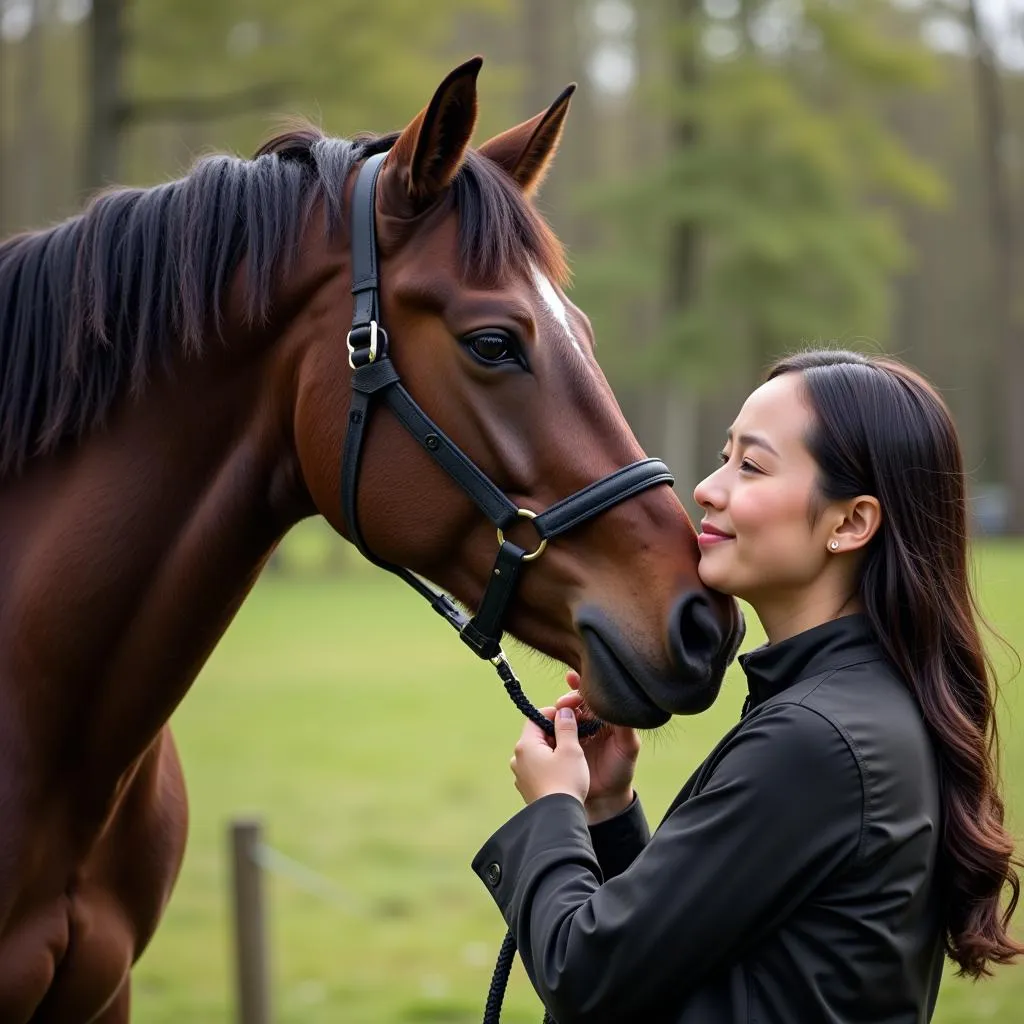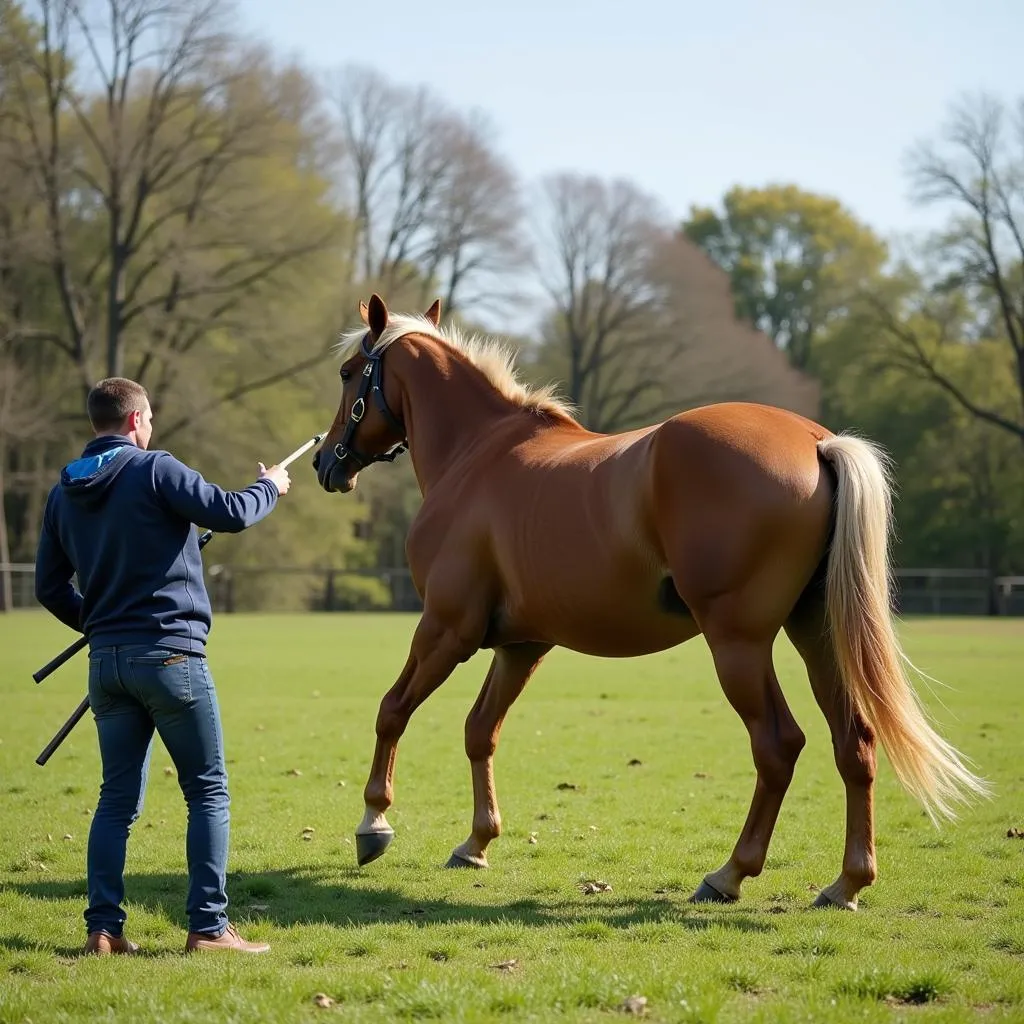Horse Reality Training is a method of interacting with and training horses that emphasizes clear communication, mutual respect, and a deep understanding of equine psychology. It goes beyond traditional dominance-based techniques, focusing on building a genuine partnership between horse and handler based on trust and cooperation. This approach recognizes horses as sentient beings with their own thoughts, feelings, and motivations.
Understanding the Principles of Horse Reality Training
At its core, horse reality training revolves around the concept of pressure and release. This doesn’t involve physical force or intimidation. Instead, it utilizes subtle cues, body language, and positive reinforcement to guide the horse towards desired behaviors. By applying gentle pressure—such as a light touch or verbal cue—and then releasing it when the horse responds correctly, you create a clear system of communication that the horse can easily understand.
This method encourages handlers to see the world from the horse’s perspective, acknowledging their natural instincts and sensitivities. By doing so, you can create a training environment that is less stressful and more conducive to learning.
Benefits of Horse Reality Training
Horse reality training offers numerous benefits for both horses and their handlers, fostering a healthier and more harmonious relationship:
- Reduced Stress and Anxiety: By prioritizing clear communication and avoiding forceful methods, reality training minimizes stress and anxiety in horses, making them more receptive to learning.
- Enhanced Trust and Respect: Building trust is paramount in this approach. As the horse learns to rely on your consistent cues and fair treatment, a bond of mutual respect develops.
- Improved Communication: Reality training sharpens your observation skills, enabling you to understand and respond to your horse’s subtle cues, fostering clearer communication.
- Increased Willingness: When horses feel safe and understood, they are more likely to willingly participate in training sessions and offer desired behaviors.
- Enhanced Safety: By teaching horses to respond calmly to pressure and release, you promote a safer environment for both handler and horse, minimizing the risk of accidents.
 Horse and Handler Bonding
Horse and Handler Bonding
Key Techniques in Horse Reality Training
Several key techniques form the foundation of horse reality training, each emphasizing communication and positive reinforcement:
- Positive Reinforcement: Rewarding desired behaviors, such as a slight head nod or a step in the right direction, with a kind word, a scratch, or a treat reinforces those actions, making the horse more likely to repeat them.
- Target Training: Using a target, like a stick with a flag on it, you can teach your horse to follow your cues by touching their nose to the target. This builds focus and encourages responsiveness.
- Groundwork Exercises: Leading, backing up, and yielding to pressure are fundamental groundwork exercises that teach the horse to respect your personal space and respond to your body language.
- Liberty Work: Working with your horse at liberty, without ropes or restraints, strengthens your bond and allows you to communicate through subtle cues, building trust and responsiveness.
Common Misconceptions about Horse Reality Training
Despite its growing popularity, horse reality training is often misunderstood. Here are some common misconceptions:
- It’s Permissive: Reality training doesn’t equate to letting the horse do whatever it pleases. It requires clear boundaries and consistent expectations, communicated through gentle guidance.
- It’s Only for Experienced Handlers: While experience is helpful, the principles of reality training are accessible to anyone willing to learn about equine behavior and communication.
- It’s Time-Consuming: While building a strong foundation takes time, the long-term benefits of a well-trained horse through reality training often outweigh the initial investment.
 Horse Following Target During Training
Horse Following Target During Training
Getting Started with Horse Reality Training
Embarking on the journey of horse reality training requires patience, observation, and a genuine desire to understand your horse:
- Educate Yourself: Begin by researching and understanding the principles and techniques of horse reality training. Numerous resources, including books, online courses, and experienced trainers, can provide valuable guidance.
- Start with the Basics: Focus on building a strong foundation with groundwork exercises like leading, backing up, and yielding to pressure. These fundamentals will pave the way for more advanced training.
- Be Patient and Consistent: Remember that horses learn at their own pace. Celebrate small victories, remain consistent with your cues, and avoid rushing the process.
- Seek Professional Guidance: If you encounter challenges or feel overwhelmed, don’t hesitate to seek guidance from a reputable horse reality training professional.
Conclusion
Horse reality training offers a compassionate and effective approach to building a partnership with your horse based on trust, respect, and clear communication. By embracing the principles of pressure and release, positive reinforcement, and a deep understanding of equine behavior, you can unlock your horse’s true potential while fostering a bond that enriches both your lives.
FAQs about Horse Reality Training
1. Is horse reality training suitable for all breeds and temperaments?
Yes, the principles of reality training can be adapted to suit the unique characteristics of different breeds and individual horses.
2. Can I transition my horse to reality training from a different training method?
Absolutely. With patience and consistency, horses can adapt to new training approaches. However, it’s crucial to introduce the concepts gradually.
3. How long does it take to see results with horse reality training?
The timeframe varies depending on the horse’s age, temperament, and previous training experiences. However, consistent effort will eventually yield positive results.
4. What are some common mistakes to avoid in horse reality training?
Inconsistent cues, using excessive pressure, and neglecting positive reinforcement are common pitfalls to avoid.
5. Where can I find reputable horse reality training resources and professionals?
Organizations dedicated to ethical horsemanship often provide lists of certified trainers and resources. Online forums and communities can also offer valuable insights.
Still have questions?
Contact our dedicated team at Justus Horses USA. We’re available 24/7 to provide personalized guidance and support. Reach us at:
Phone: 0772127271
Email: [email protected]
Address: QGM2+WX2, Vị Trung, Vị Thuỷ, Hậu Giang, Việt Nam
Explore our website for more insightful articles on sky dancer horse and other equine topics.